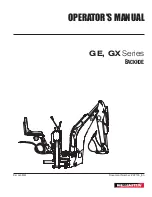
1523.6-0000010 OM
216
6.15.2 Check of voltage supply
Check of voltage supply shall be carried out in case of circuit malfunctioning. Connect one
of the tester wires either to the negative battery terminal or to the tractor safe “weight”. The
other tester wire shall be connected to the terminal of the circuit electrical connection,
preferably the one located nearer to the AB or the fuse. If the pilot lamp on the tester lights
up, there is voltage on this circuit segment which proves circuit operability between this
terminal and AB. Acting analogically, inspect the rest part of the circuit. Detecting absence
of voltage supply indicates the failure between this circuit point and the last of the checked
before (where voltage supply was detected). In most case, the reason for malfunctioning is
weakening of electrical connections and contact quality break. Remember that voltage to
some of the on-board electrical equipment circuits can be supplied only in the positions of
starter and instruments switch “I” (instruments on) or “II” (starter on (unfixed position)).
6.15.3 Search for short circuit
One of the short circuit search methods is removal of the fuse and engagement of the
lamp-tester or a voltmeter instead of it. There shall be no voltage in the circuit. Shake the
wire looking at the lamp-tester. If the lamp starts blinking, there is short ground failure in
this cable, possibly caused by rubbing of wire isolation. A similar check can be carried out
for each of the circuit elements including the switch of this circuit.
6.15.4 Check of availability of the electrical element “load”
This check is carried out with the purpose of determining the availability of electrical ele-
ment safe “load”. Disengage AB with the “load” switch and connect one of the wires of the
continuity test lamp equipped with the self-contained power supply to the safe “load”. The
other lamp wire shall be connected to the cable or terminal which is being checked. If the
lamp lights up, grounding is normal (and vice versa). If the minus supply circuit of the high-
current consumer is under checking, it is required to use the continuity test lamp with the
power not less than 21V because with the bad contact of the “load”, the consumer fails to
operate and the lamp with small power will light up.
6.15.5 Check of electrical circuit breakage
This check is carried out with the purpose of determining electrical circuit breakages. After
disconnection of circuit power supply, check it by means of a continuity test lamp equipped
with a self-contained battery. Connect the continuity test lamp wires to both sides of the
circuit (or to the high-power end (+) and to the reliable tractor “load”), if the control lamp
lights up it means the circuit has no breakage. The lamp failure to switch on indicates that
the circuit has conductivity fault.
The switch operability can be checked in a similar way by connecting the continuity test
lamp to its terminals. While shifting the switch into the position “On”, the control lamp shall
light up. In this case if the switch commutating supply for a high-current consumer is under
check, it is also required to use the continuity test lamp with the power not less than 21
kW. The reason is that with the bad contact in the switch, a high-current consumer fails to
operate and the lamp with small power will light up.
6.15.6 Breakage localization
While carrying out diagnostics of the circuit segment suspected of breakage, it is difficult to
detect circuit breakage visually as inspection of terminals for presence of corrosion or their
defects in contact quality can be difficult due to access limitation to them (as a rule termi-
nals are covered with the connection housing). Abrupt shaking of the connection housing
on the sensor or of the bundled cable leads to conductivity recovery in many cases. Re-
member this when trying to localize the reason for failure of the circuit suspected of break-
age. Occasionally arising failures can be caused by terminals oxidation or defects in con-
tact quality.







































